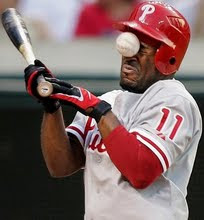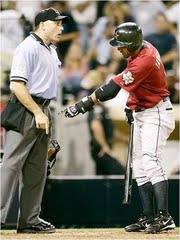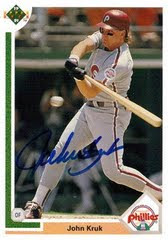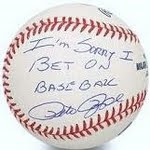I know this post is extremely long but it's really interesting. (Although it was actually a lot shorter on my Word document when I wrote this)
How do you define greatness? Easily, actually. In basic terms, you determine a standard category and see who best fits the terms of the category. How do you determine who's the greatest guitarist? You can look at skill level of songs and creativity. Granted these terms may not be completely objective but you can still easily create lists to fulfill your standard. How do you determine who's the greatest baseball batter? Even easier, look at OPS. How well a person draws walks and can hit for power. That's the great thing about baseball, there's so many categories that CAN be determined objectively that's it's easy to create lists of who's the best not only year to year but all time. How do you determine who's the greatest football player of all time? Well that's where a problem occurs. You can create a standard category but how do you determine who fulfills that category? This is where statistics can become a problem. First of all, some positions don't have statistics! For example: offensive guards, offensive tackles, fullbacks. Even to some extent linebackers and safeties. Let's use offensive guards and tackles as examples. First, what standard can be used to determine who the best is? Well that's easy. There two functions which are run blocking and pass blocking. The best offensive linemen are great at pass and run blocking. OK, second, how do you determine who is the best at blocking? In a great book called The Hidden Game of Football (a prelude to Football Outsiders, essentially football sabermetrics), they try to tackle this problem. Unfortunately, they look at the best linemen off all time and they use pro bowl selections. This doesn't help us when we are trying to determine who deserves to go to the pro bowl. Recently, statisticians use sack percentage: how often the person an offensive lineman is blocking gets a sack. This is a start but there are three problems with this. First, what if an offensive lineman continually lets his defender come through yet the quarterback is mobile enough to continually not get sacked? Is that offensive lineman really good even though he let's no sacks get through? No. Second, What about run blocking? There's absolutely no way to statistically determine this. Third, often, there's more than one lineman guarding specific blockers. How can you determine who's the best if you are getting help. However, if you're a football fan, you can easily determine if your lineman sucks or not. You see, you just have to watch to see how is good or not. But it's essentially impossible to watch every single player at every single to accurately determine who is good or not. That's why you want to look at statistics. But as we just determined, that's not always possible. So with that being said, here's my list of how to determine (or not) of who should go to a pro bowl:
Positions You CAN Determine Pro-Bowl Selections For:
- Quarterback. This is one of the easiest to judge. While a quarterback NEEDS a good offensive linemen and competent receivers to have good numbers (and a running game helps but not necessary), you can look at statistics to see who is good or not: Important stats to look at: Average yards per play (AYP), TD/INT ratio, completion percentage, and quarterback rating (while as an individual statistic it's so good but if you're the top of the of league in rating you're generally good).
- Running Back. Also a very easy stat. Yes, an offensive lineman and possibly a fullback are EXTREMELY important for a RB to be good. Let's face it, Jim Brown in front of the 2008 Detroit Lions offensive line would obviously not put up as good of number as he did. Yet the great ones still put up good objective numbers. One important fact to note is that the vast majority of teams have multiple RBs therefore some good, pro bowl caliber backs lose carries and therefore lose some points in some categories, but if a RB fulfills the vast majority of the categories, then they are good. Important stats to look at: Average Yards per Carry (AYC), TDs and to some extent receptions. Receptions aren't important because if you have a back that has a lot of TDs and a high AYC then who cares if your back can't catch? Average Yards per Carry is THE most important stat. How well a running back can do on each individual play is the most important. And FUCK total yards. The guys who have a lot of total cards also have a crap load of touches, usually. Set all carries equal and see how total yards shake up. However, one still must take carries into account. A player can have a great AYC but if that same player only has about 50 touches well then, that player isn't really a pro bowl. So it's not the exact amount of carries that matters just as long as a player with a high AYC also has a significant amount of catches.
- Wide Receiver. Can someone please truly tell me the difference between these two stat lines? Player 1: 2 catches, 100 yards, TD and Player 2: 10 catches, 100 yards, TD. Sure Player 1 did the exact same thing as Player 2 but in 8 less catches, but who cares? The thing is, being a wide out is not about being efficient when you catch the ball; it's just all about catching the ball. Quarterbacks and running backs are extremely independent. They essentially start off with the ball and then decide what they want to do when they have the ball. Receivers on the other hand are dependant; they have to rely solely on the QB. And when you look at the scheme of things, WR only get thrown to about an average of ten times a game. Out of all the plays a team runs, the ball is in the receiver's hands for very little time. That is why similar stats you can use to determine QBs and RBS should not be used to determine WRs. Important stats to look at: Yards per Game and TDs. And really, wide outs get very little TD tosses and very little TDs. So when a WR has a significant amount more of TDs than his competitors it's significant, but a player can be a great wide out with little to no TDs. One stat that I think should be the most important is thrown to/ receptions ratio. First of all, I can not find out this stat so it's hard for me to judge receivers on this. Secondly, this stat can be screwed a little because sometimes QBs will "throw to" a receiver just to avoid a sack or an intentional grounding call and that shouldn't count against a receiver. But really, how many yards a player can get per game over and over again is very important.
- Tight End. The thing about a TE is that they are a combination of a wide receiver and an offensive lineman. Since we can not objectively judge how well anyone blocks, we must unfortunately judge TEs on their receiving skills. Therefore, the same way we should judge WRs is the same way we should judge TEs. Important stats to look at: Yards per Game and TDs.
- Center. This is really the only "blocking" position that can be measured through stats. The thing is, a center is in charge of the entire offensive line. While granted, unfortunately, an offensive line and a center is not a causal relationship, but if an offensive line is good, it is because of its center. And in fact, Football Outsiders use DVOA to judge how well lines as a whole are. So is a team's offensive line is one of the best, then so is its center. Important stats to look at: offensive line DVOA
- Kick Returner: Easy, just look at a returner's average yards per attempt. TDs are not extremely important because really, I know we are all so used to Devin Hester, but in reality, there are so few TDs scored on kick returns. Plus, if a returner does have a lot of touchdowns, they will have a high average because it takes a lot of yards to run back a kick for a TD. Important stats to look at: Average Yards per Return.
- Kicker: Another easy one. All a kicker has to do is kick the ball like 5 times a game. How efficient a guy is at kicking shows how well the kicker is. You can not clearly look at total points because this is determined by FG attempts. One other important fact that's important is percentage of kicks a guy makes from 50+ yards. These kicks are hard. The best kickers should have a decent percentage of kicks from 50+ yards AND from everywhere else. Because let's face it, as awesome as Robbie Gould is because of his high percentage rate, the fact he can't make a kick from at least 50 yards is a major flaw of his. One important point to note: amount of or percentage of game winning field goals is crap. If a kicker is good, it doesn't matter when the game situation is. Important stats to note: FG percentage and FG percentage from 50+ yards.
- Punter. The punter's job is to make sure the opposing team has the worst field position possible. This means both kicking it so the punt returner has a hard time returning the kick and kicking it far and accurate enough to cause trouble to the opposition if the ball is not caught. Important stats to look at: percentage of kicks within the 20 and average net yards per punt. A beaming kick that's caught at the 5 yard line does nothing if it's brought back for a TD. That's why you have to subtract how far the kick went from how far the punter punted it. This is net yardage and the average of this net yardage determines the best. Also, kicks within the 20 means the punter is doing his job making it as hard as possible for the opposition to return kicks
- Defense Ends: The one can get tricky because people tend to judge DE's by sacks. This is tough for two reasons. First, a DE has to do more than pass block, he also has to run block. Secondly, in passing situations, a great DE can apply heavy pressure to the QB without making a sack, yet he did his job perfectly. Yet at the end of the day, players that accrue the most sacks and generally the best defensive end, just please be aware sacks are not the be all end all. Plus, in 3-4, the linebackers, not the ends do the majority of the sacking. Important stats to look at: sacks and tackles for losses.
- Cornerbacks. The primary goal of a CB is to make sure the opposing team's receivers do not get catches. Their goal is not to make interceptions, but to stop receivers from doing their job. Interceptions are misleading. What if let's say you have a cornerback who is pretty bad. Let's call him DeAngelo Hall. This CB is so bad that QBs throw to the receiver he is guarding often. Let's say he is thrown on so much that every once in a while he is able to get an interception. Eventually he may even be in the top 5 in the league in INTs. Is he really a pro bowler? Hell no, he's barely a competent back. In fact, a good many CBs that are pro bowl caliber do not get a lot of INTs because of how well they cover their receiver. Important stat to look at: guarding receivers total numbers. Unfortunately ESPN and NFL.com do not post these stats but you can figure out how often a CB is thrown on and how bad their receivers do. There MUST be a way considering ESPN shows these kinds of stats all the time.
Position You Can SORT OF Determine Pro Bowl Selections For:
- Linebackers. The two main stats people use are tackles and sacks to measure a linebacker's success. Major problems with these. First with sacks. Not all systems require the LB to blitz the QB. In 3-4 systems, they are supposed to. In 4-3, they are not (per se). If you're a linebacker in a 4-3 system, you shouldn't be penalized because you're not asked to rush the passer often. Second, we'll talk about tackles. The same reasons interceptions suck is the same reason tackles suck. If you're a linebacker and you're defensive line is terrible at run blocking, you're going to have a lot of players run you're way. Eventually, you're going to accrue you're far share of tackles. This doesn't mean you are great, it just means players around are not. That being said, you still can kind of sort of determine pro bowlers. LBs that are asked to blitz a lot and are good at it should not be penalized for being good at what they do and get a lot of sacks. Plus, great LBs tend to be pretty good in whole bunch of stats like INTs, sacks, forced fumbles, tipped balls, etc.
- Safety. You know who the best safeties are. You just do. You know how awesome Troy Polamalu and Ed Reed are. The problem is that you don't really have statistics to prove this. One good way of proving how good a safety is by looking at how well a defense does with and without the safety. For example, look how well the Colts and Bears run defense performs when Bob Sanders and Mike Brown, respectively, are not healthy. However, what if a player is always healthy? Then this will prove nothing. Polamalu and Reed have a high numbers of INTs, but as we have proved before, INTs are a shitty stat. But one stat dismissed before is actually a decent measure of a safety's performance, tackles. The thing is, a safety's job is to make sure a receiver or ball carrier does get tackled. If a cornerback let's his receiver catch a ball, it is the safety's job to tackle said receiver. They are set in place as a protection for when people mess up, because they will. However, a good safety paired with a bad cornerback will probably have an unnecessary amount of tackles. So you can look at tackles, INTS, and defensives as a whole, however there is no clear cut way to determine the best of the best.
- Defensive Tackle. If a DT has a large amount of sacks, they are automatically amazing. But the vast majority of DTs do not have a lot of sacks. One measure people might say is to look at a team's run defense and if that is good then the DTs are good. Two problems with this: 1) there are more players like LBs and Ss that help with run blocking and 2) if a team does a good run defense which DT do you give credit to? Honestly, I know Pat Williams and Kevin Williams are fucking awesome, but I can not tell you which one is better than the other. The problem we encounter with run blocking creates the problem with run defense, it's just hard to objectively determine how well a guy can do with run tackling and blocking.
Positions You CAN NOT Determine Pro Bowl Selections For:
- Offensive Guards. If you can give me a concrete way to determine how well a guy pass blocks AND run blocks, please tell me. As I pointed out in the beginning, this just isn't fully quantifiable.
- Offensive Tackles: See above
- Special Teamers: Seriously, what makes Brandon Ayanbedejo so good? Why does he keep going to the pro bowl every year? I don't even know what standards to use to determine what makes a good special teamer? Does he tackle well? Does he block well? Does he run fast enough to force the kick returner to call for a fair catch? Does he strip the ball well? WHAT!? Seriously, this is a completely bullshit category and should be taken away as one.
- Fullback. The fullback's main job to do is block. And as we have fully discussed, run blocking is essentially not quantifiable. I guess an argument can be made that if a RB is good and outs p really good numbers then the FB must be doing something right? Well, maybe, the problem is what is the causal arrow? The FB may not necessarily make the RB good. What if the RB is good that it doesn't matter that the FB missed his run blocking assignment? What if a fullback does his job to a tee but his RB is kid of bad and gets easily tackled no matter what? Again, a fullback run blocks and this can't be put into numbers.







0 comments:
Post a Comment